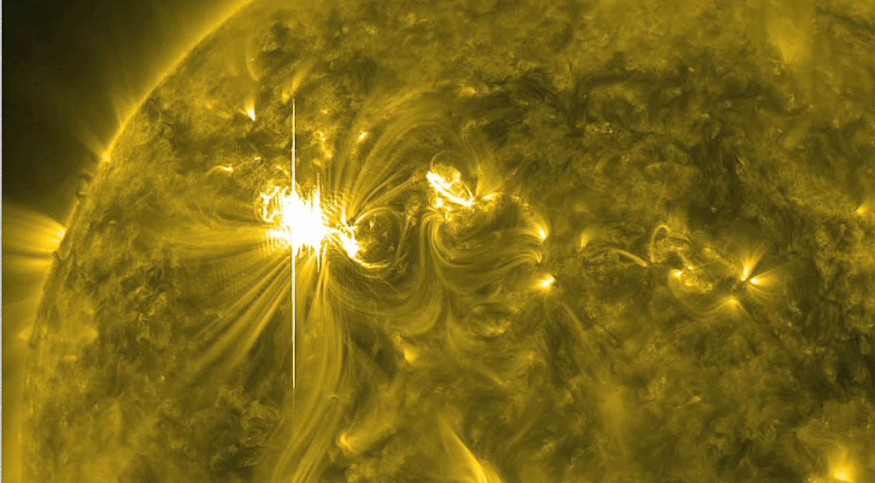Solar flares happen simultaneously. But note that they're part of our Sun's 11-year cycle, separated between the minimum and maximum phases. The rate of solar flares is primarily triggered by the presence of solar activity such as solar storms, which depends on the stage.
Solar flares have been at the forefront of astronomical and scientific investigation and research for decades as a manifestation of an intense solar storm in our solar system's sole star. Some of the fascination with the solar phenomenon stems from the possibility of a catastrophic impact on the planet.

In this handout from NASA/Solar Dynamics Observatory (SDO), a X5.4 solar flare, the largest in five years, erupts from the sun's surface March 6, 2012.
Can Solar Flares Really Destroy Earth? NASA Says Probably
According to Stanford University's solar center homepage, a radio show supposedly claimed that radiation from a major solar flare in the future might destroy most existing life forms on Earth. However, current astronomical knowledge of solar flares contradicts this.
Douglas Biesecker of the University of Birmingham - School of Physics and Space Research in England, UK, responds to the prediction on the homepage, noting that the answer is not absolute.
Human civilization has never seen a planet-killing solar flare or any other solar phenomenon emerging from a solar storm. According to Biesecker, the magnitude or volume of a solar flare has little bearing on whether it may create a life-threatening or extinction catastrophe.
Instead, Biesecker underlined that specific elements, such as the overall amount of photons and particles from various energies from the solar flare that would reach the planet, are required for Earth to be seriously harmed.
According to NASA's Goddard Space Flight Center (GSFC), solar flares constitute a hazard to most living species. However, humans are protected from high-energy particles and radiations by the Earth's atmosphere and magnetosphere and the planet's magnetic field.
As a result, solar flares have no effect on humans and animals living on Earth's surface.
What is a Solar Flare? Experts Point Out How This Happens
A solar flare is an intense burst of electromagnetic radiation from the Sun's atmosphere, according to the National Aeronautics and Space Administration (NASA). It is thought to be the most powerful explosion ever seen in our solar system.
Solar flares are distinguished by their intense bright lights, made up of particles known as photons. These are monitored using a variety of methods, including x-rays and optical light. According to NASA, solar flares also accelerate other particles like protons and electrons.
Solar flares are sometimes defined as an outward rupture of high-intensity radiation that is short-lived. In a nutshell, they resemble a flash of light. These solar events are frequently linked to sunspots and have the potential to trigger an electromagnetic storm on Earth.
Satellite Technology Affected
Solar flares, along with other solar phenomena such as coronal mass ejections (CME), can generate a geomagnetic storm that disrupts Earth's magnetic field and ionosphere, albeit this is not the case for living things.
This outage affects all satellite-based devices and equipment, including airplanes, cellphones, laptops, televisions, radios, and more.
The magnetic storm interrupts satellite communications and radio waves, affecting the internet, satellite signals, and the global positioning system (GPS), among other things.
RELATED ARTICLE : Sun Had Another Geomagnetic Storm; Horrifying Solar Flare, Stunning Northern Lights Seen In US Skies
Check out more news and information on Space in Science Times.
© 2025 ScienceTimes.com All rights reserved. Do not reproduce without permission. The window to the world of Science Times.












